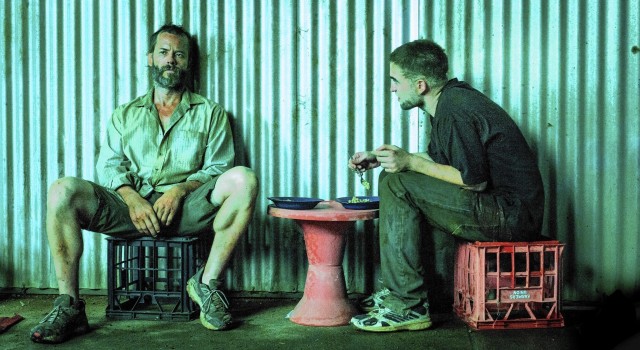It’s not personal. It’s just programming.
Athena responds to adult Frank’s bitterness at the way his childish love for her was thwarted.
Tommorrowland is a much stranger film than it may first appear. Brad Bird, director of The Incredibles and Mission Impossible: Ghost Protocol, has seamlessly blended together state of the art CGI animation and live action. Personally, not since I was a child have I sat and marveled at action sequences in the way I have here. Sequences such as the rocket launch depicted above seem to operate within a digital-era upgrade of Todd-AO, pushing at the vertiginous vision of Cinerama technology – which would have been state-of-the-art cinematic gimmickry back in the 1950s origin points of Disneyland’s original Tommorrowland. There may be periods of talking heads plot development spread throughout the film’s 130mins running time, but the opening hour flies by at a fearsome pace, and the Tommorrowland myth is a rather awesome and otherworldly experience, laden with plenty of discrete visual detailing and unnerving ebullience. As much as I found myself increasingly unsettled by the brightly-lit positivist agenda of the film, the spectacle, the energy and the dynamism nonetheless sucked me in. We’re not in Kansas anymore, but we might well be in Nazi Germany.
Bird clearly believes his material and wants an audience to embrace the uber-positive message of not giving up on a dream, as well as realising our innate capacity to find solutions to problems through community and teamwork. At times the films geekish glee is all a little too saccharine, particularly within the closing stages of the film, where Bird seems to be mainlining a slightly more humane version of Randian positivism in the guise of a technology cult. Yet bolstering this belief are the nascent myths of yesteryear: American exceptionalism, technological progress as a positive force for change, the grand tradition of the American Dream, an unquestioning belief that the future can be written and rewritten by our individual actions (whether collectivised or not). As much as Bird’s futuristic fantasia is about what may yet come, it is also embedded within a very nostalgic reactionism for a period in history where things seemed much simpler and innocent. This is the to-and-fro at the core of the film. Do we turn backwards and bury our head in a play park Tomorrowland, or do we reach forward and forge something better from those past failures and smallscale divertissements?
The film also scores highly by being supremely well cast. Clooney is a past master at grouchy and put-upon and his adult Frank Walker has just the right degree of hurt defensiveness and disillusionment. His character is very much a love-scarred little boy trapped in a failing adult body, his emotions stunted in their growth and buried deep beneath the skin, which still remains tender to verbal attack. The young performers, Britt Robertson and Raffey Cassidy, play Casey and Athena, and both of them are excellent. Cassidy has the more obviously awkward and demanding role, having to play an impish young girl with a disturbing secret. The power of her performance creates a particularly awkward tension in the middle third of the film when the thwarted romance between herself and Clooney’s adult Frank is played out as a long-deteriorating relationship. Clooney is so good at unlocking his narrow-minded, selfish little boy and Cassidy has such archness and poise, that the absurd age gap between the two performers falls away creating an incredibly intricate and unusual soured romance. Robertson’s Casey is yet another young teenage schoolgirl becoming progressively more empowered, although here that empowerment is realised through her blithe optimism and can-do attitude. Casey is an elect figure, very much in the tradition of other contemporary sci-fi sagas, but her qualifications for heroism seem to be much more grounded in the unbridled enthusiasms of youth, than any fantastical powers. Unlike Katniss in The Hunger Games, Casey isn’t on a quest to grow up and set aside her childish things, but rather to remake the world with the undimmed optimism of childhood. Ultimately, it is this desire to remain grounded in the child’s enraptured experiences of ‘newness’ and wonder that makes the film such an unusual proposition. Casey, as the film’s heroine, is likely its secondary character, as it is really a story about the reintegration of Clooney’s disenchanted Frank, back into the enthusiasms and optimism of childhood, when the world promised to be so much more.
Oddly, Bird never once makes Tomorrowland actually look like the appealing dreamworld that he seems to wish the audience to be intoxicated by. First of all Tomorrowland is a bizarrely upbeat place of benign niceties and hollow spectacle. Then it becomes the anodyne and cloistered cocoon of Nix’s (a beyond hammy performance from Hugh Laurie) paranoid self-righteousness. Before finally becoming a singularly driven place of creative ambitions, bathed in permanently golden sunlight and wreathed in an equally brilliant agrarian corn-belt of contentment. The positive future projection that Bird has constantly talked up as being the divergence point between Tomorrowland and so many other cinematic futureworld science fictions of recent years, still contains within it a palpably unhinged and disturbing sense of dystopia, even whilst zealously endeavouring to imbue us all with entrepreneurial spirit. Looking at that closing scene what Tomorrowland are we actually seeing? The glorious, halycon step into the light, the vital spark? Or are we looking at a new fascism of the ‘gifted’, an elect of the can-do?





